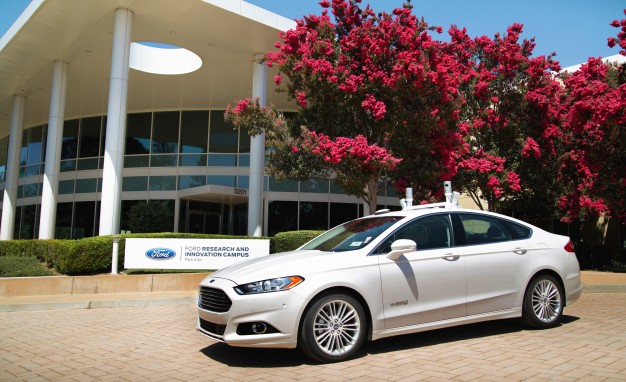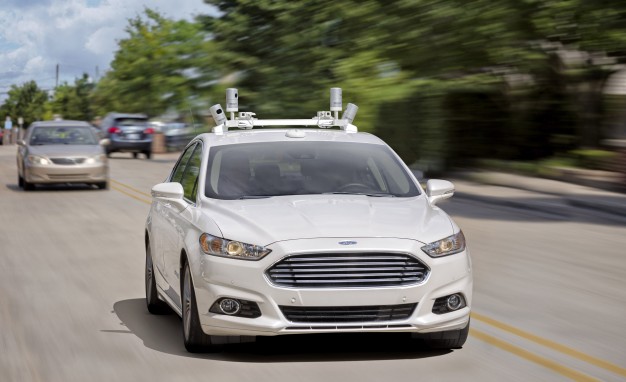
–
Ford has finally made its move.
–
After months of listening to Wall Street analysts gnash their collective teeth about the company’s lack of acquisitions and partnerships related to self-driving technology, the Detroit automaker unleashed a series of announcements Tuesday related to its efforts to develop and deploy autonomous vehicles in an increasingly competitive field.
–
Chief among them: Ford CEO Mark Fields told a group gathered at the company’s Silicon Valley research facility that Ford intends to produce fully autonomous cars for ride-hailing and ride-sharing operations by 2021. The vehicles will be manufactured in high-volume production and will be tailored for these operations, meaning they won’t contain steering wheels, brake pedals, or other controls for human occupants.
–
“Autonomous vehicles are going to open up opportunities for the elderly, people with disabilities, and people not old enough to drive themselves,” Fields said. “So we’re designing the first generation of autonomous vehicles specifically to be used for ride-hailing and ride-sharing, which is another seismic shift in the transportation landscape.”
–
The five-year timeline for the arrival of autonomous technology falls in line with projections from competitors. Ford says its autonomous vehicles could support electric batteries, but it won’t divulge further powertrain details until closer to the launch date. The company currently operates a test fleet of hybrid Ford Fusions in Michigan, California, and Arizona. That test fleet has tripled in size, growing from 10 to 30 cars, in 2016. Fields said Tuesday he expects the test fleet to triple again by the end of 2017.
–
–
–
–
–
As it rushes to ready mass-produced vehicles for the commercial market, Ford chief technology officer Raj Nair said Tuesday the company is either investing in or partnering with four startup companies that will augment and refine the company’s knowledge of the sensors and algorithms critical to making autonomous technology work.
–
First, the company said, it will further invest in Velodyne, a leading provider of lidar sensors that capture high-resolution images of the area around vehicles. Ford and Velodyne have been collaborating on autonomous driving for a decade, and at CES in January, Ford said it would be Velodyne’s first customer for its new solid-state Ultra Puck sensors. Fields also said Ford has acquired SAIPS, an Israel-based computer vision and machine-learning company, to strengthen its expertise in artificial intelligence.
–
The CEO was just getting started. He said the company is increasing its investment in Civil Maps, a California-based company that develops high-resolution 3D maps, and that Ford has signed an exclusive licensing agreement with Nirenberg Neuroscience, a machine-vision company that specializes in object recognition and bringing human-like levels of intelligence to machine modules.
–
Further, Fields said the company is increasing its footprint in Silicon Valley. It will build two new buildings at its Palo Alto, California, campus and double the size of a workforce there that currently numbers approximately 130 scientists, researchers, and engineers.
–
After watching rivals General Motors make a $ 500 million investment in ride-hailing service Lyft and Fiat Chrysler Automobiles partner with Google on self-driving development, Ford has been criticized for keeping its developments in-house under the Ford Smart Mobility subsidiary created earlier this year.
–

–
As he rattled off the list developments Tuesday, Fields enjoyed poking at his Wall Street critics.
–
“You might have noticed we’ve taken our time to discuss our autonomous-vehicle plans,” he said. “Very simply, we are not in a race to make announcements. We’re in a race to do what’s right for our customers and our business.”
–
Increasingly, Ford believes that race involves a push toward fully autonomous cars that are capable of driving themselves for the entirety of a journey, what’s known in the industry as Level 4 automation. Ford doesn’t believe it is worth the effort to pursue incremental technologies that leave humans in the driving loop. That has been the company’s position in the past, and executives doubled down on it on Tuesday.
–
“I want to be clear about what our strategy is not—it’s not about Level 3 automation that would still require a driver,” Nair said. “What we found in research is, there’s a challenge with Level 3, and we don’t yet know how to manage a handoff back to a driver, have him situationally aware enough to re-engage in a safe manner.”
–
- –
- New Software Aims to Speed Autonomous Development
- Delphi Intends to Deliver Fully Autonomous Cars By 2022
- GM Content to Take Slow Lane Toward ‘Super Cruise’ Feature
–
–
–
–
Not to mention, that steppingstone approach wouldn’t provide the commercial opportunity Ford sees in removing drivers from the business equation. The automaker is banking on autonomous driving to provide new profits. Without drivers, Nair says, the revenue possibilities from ride-hailing, autonomous shuttles, and package deliveries become attractive to Ford.
–
Ford is hardly the only company that foresees the commercial possibilities involved when human drivers are removed. Delphi Automotive, for example, embarked on the first phase of a test program in Singapore earlier this month that explores the possibility of using shared autonomous vehicles for both passenger and cargo purposes. BMW, Mobileye, and Intel announced last month they’re partnering on fully autonomous technology to apply in a shared environment by 2021.
–
The race to bring these shared services to the market is mushrooming throughout the transportation industry. If nothing else Tuesday, Ford assured any doubters that it is very much a part of the competition.
–




